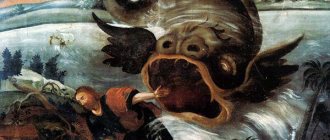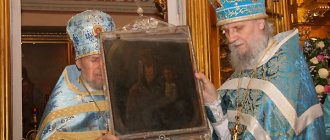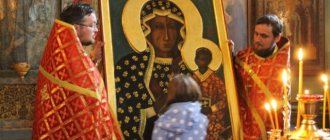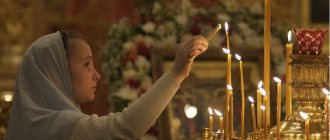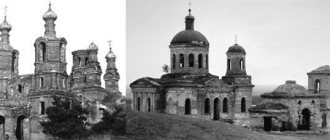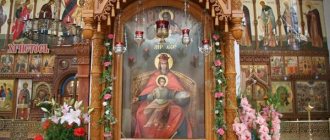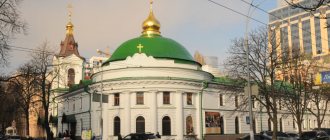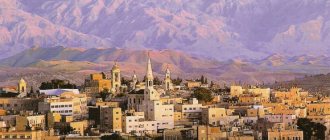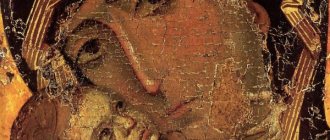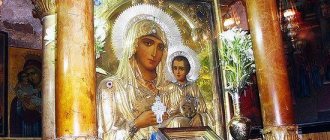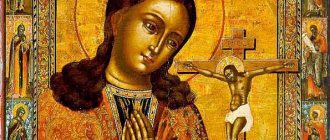November 2021 11/13/2019 16:41
Prayerful veneration before the icons of the Mother of God is an amazing phenomenon of the Christian tradition. Where a person finds God as his Father, the Most Pure Virgin Mary becomes his Intercessor and Comforter.
Through her miraculous images, the Mother of God sends Her heavenly help to everyone. There is a wide selection of icons of the Image of the Queen of Heaven in the Holy Protection Church - https://ikonaonline.ru/collection/bozhya-mater
The Holy Tradition of the Church says that the Apostle and Evangelist Luke was the first to depict the Mother of God in iconography. The Blessed Virgin prophesied that the Grace of God would abide with her images. This is how the first icon of the Mother of God appeared. Subsequent images of the Mother of God in their iconography originate from the works that Saint Luke did.
Varieties of Orthodox icons of the Blessed Virgin Mary with names
In the Russian Orthodox calendar there are about two hundred and sixty venerated icons of the Mother of God. The total number of images of the Mother of God is about eight hundred and sixty icons. Let's look at several of the most famous types of images of the Blessed Virgin Mary.
Kazanskaya
It is one of the most common images of the Mother of God. The Mother of God herself is depicted half-sided up to her shoulders, and the Baby Jesus sits on her arm. Their gaze is directed at the person praying. It is customary to bless newlyweds with this icon for their wedding; it is hung near children's cribs.
Inexhaustible Chalice
A miraculous icon, known since the end of the nineteenth century. According to legend, this image of the Mother of God appeared to the world as a source of help for people suffering from alcoholism. The image shows the Mother of God herself, and in front of her is the baby Jesus Christ standing in a bowl. The original image was lost in the twenties of the last century.
Feodorovskaya
One of the early images, painted, according to legend, by the Evangelist Luke. At the site of the apparition, a monastery was built in the name of the Savior Not Made by Hands. The icon depicts the Mother of God with a baby hugging her clinging to her cheek. On the reverse side was the image of the holy martyr Paraskeva Pyatnitsa, patroness of weddings.
Sovereign
The image was found for the first time during the February and October revolutions in the basement of the Ascension Church in the village of Kolomenskoye. It is the main shrine of Russian monarchists. According to legend, it is considered a symbol of the fact that the fall of the monarchy was sent to the Russian people as punishment for sins.
Vladimirskaya
According to legend, it was written by Luke during the life of the Virgin Mary, on the table at which Jesus Christ, the Mother of God and the righteous Joseph had a meal. The image was in Palestine until the middle of the fifth century AD, after which the icon was transported to Constantinople. In the twelfth century, a copy was sent to Kyiv.
Tikhvinskaya
Another of the early icons attributed to Luke. It was in Constantinople until the fourteenth century, after which it disappeared. Chronicles say that at the same time she appeared to fishermen on Lake Ladoga near the city of Tikhvin.
Three-handed
It represents the image of the Virgin Mary with a baby on her right hand. A human hand is depicted under the right hand. Traditionally, the third hand is considered to belong to the Mother of God.
Unexpected joy
Written under the influence of Dmitry Rostovsky’s story about a miraculous vision of a sinner, which talks about a man who prayed to the icon of the Mother of God, and then committed a crime. One day he saw the image moving. Christ's wounds opened and blood poured out. The sinner asked for mercy. The image repeats the plot of the story - in the lower left corner there is a man praying in front of the image of the Virgin Mary and Child, in torn clothes and with sores.
Blissful womb
The icon depicts the Mother of God sitting on a pillow with a baby in her arms, who clings to her chest. The image has features of Italian painting, which is why it is considered a copy of an Italian original.
Annunciation
Dedicated to the Feast of the Annunciation. The image contains the Archangel Gabriel and the Blessed Virgin Mary herself. Describes the event told in the Gospel of Luke, when the Lord sent Archangel Gabriel with the good news that Mary was destined to become the mother of the Savior of the human race.
blessed sky
The main meaning of the image is the glorification of the Mother of God as the Queen of Heaven. Its prototype was the icon “The Woman Clothed in the Sun.” The image of the Wife is usually interpreted as a symbol of the Christian Church.
Joy to all who mourn
Here the Mother of God is depicted surrounded by distressed people and angels who perform good deeds in her name. It is a symbol of the intercession of all poor, hungry, sick people.
Upbringing
Here the Virgin Mary is depicted with the Child Christ sitting on her left hand. The right hand of Jesus extends to the face of the Virgin Mary. The original image was in the Kazan Cathedral until 1917, after which it was lost due to the destruction of the temple.
Life-giving spring
According to legend, the appearance of the icon occurred in the fifth century, in Constantinople, in a grove near the Golden Gate. In this grove there was a holy spring, long glorified by miracles.
Deliverer
The icon gained its fame in the seventeenth century, when one of the Greek provinces, thanks to prayers, got rid of a locust invasion. The miracles emanating from this image attracted many pilgrims, which burdened the guardian of the shrine, Martinian.
The image of the Deliverer was carried by Alexander the Third on the train when he was traveling with his family from vacation. The train was involved in a disaster, but the royal family was miraculously saved.
Key of Understanding
Here the Mother of God is depicted in full height, and there is a key at the bottom of the image. It is a symbol of reason and knowledge. Before the image, prayers are performed before the start of children's education, as well as if children have mental retardation.
Mammal
The Virgin Mary breastfeeds the infant Christ. Sometimes depicted wearing a crown and with angels. They pray to the image for the health of babies and with requests to send more breast milk.
Everlasting color
Virgin Mary with a child on her right hand and a white lily in her left. Symbolizes the unfading light of the purity of the Blessed Virgin.
Otrada
One of the early images, considered miraculous. The origin is associated with the miraculous rescue of the son of Theodosius the Great - Arkady, who fell into the water from a sailing ship near the monastery located on Holy Mount Athos.
Childbirth assistant
An icon that women traditionally pray to for the birth of children and a safe birth. Located in the Church of the Transfiguration on Bolvanovka and in the Conception Stauropegic Convent.
Self-written
Icon from the Athonite monastery of John the Baptist. It has this name due to the fact that, according to legend, the artist who painted it could not successfully complete the work on it and put it off until the morning, leaving to pray. Then in the morning I found the image completely ready.
Quick to Hear
Prayers to this icon help in unclear situations and bewilderment. The quick to hear is a symbol of help in a difficult situation, when you urgently need to settle things or resolve some issues.
Quench my sorrows
The Virgin Mary holds the infant Christ with her right hand. In his hands is a scroll with a message to people. The image is a symbol of deliverance from illness and mental anguish.
Healer
Known for the miraculous cases of healing of people who prayed in front of this icon. It is a symbol of healing from illnesses.
Semistrelnaya
The Virgin Mary is depicted here pierced by seven arrows. It is similar to the “Softening Evil Hearts” icon, with the difference that the arrows are located on both sides of the Virgin Mary. There were many testimonies of miracles performed in the image, such as healing from illness and mental anguish.
All-Tsaritsa
This image is the most powerful for prayers for salvation from incurable diseases, including oncology. In addition, the icon protects against evil witchcraft. Prayers before the All-Tsarina help get rid of harmful addictions.
Worthy to eat
Turning to this icon can forgive the most serious sins, provided that the person praying repents for his guilt. Frees the mind and soul from sinful beliefs.
The Omen
Image of a seated Virgin Mary raising her hands in prayer. On her chest is the image of the baby Jesus Christ against the background of a round shield. It is one of the oldest icons of Orthodox Rus'.
Iverskaya
A symbol of the Virgin Mary taking the entire human race under her intercession.
Recovery of the dead
An icon dedicated to parents praying for their children, a symbol of consolation for parental grief. Before her, it is customary to pray for the health of loved ones, from whom a long separation is inevitable.
Childhood and youth
It is believed that the Virgin Mary was born in the suburbs of Jerusalem into the family of the righteous Joachim and Anna . Her parents could not give birth to a child for a long time, so after Anna became pregnant after 50 years of marriage, they decided to devote their daughter to serving God. Mary's family lived near the Lion Gate in the Old City of Jerusalem.
According to legend, when the girl was six months old, her mother put her on the floor to see if Maria could stand, but she walked exactly seven steps and returned to her arms.
Maria lived with her parents until she was three years old, after which she was brought into the temple and sent to a shelter at the temple, where the girl was raised. The introduction into the temple was a unique event, because everyone except the High Priest was forbidden to enter there, especially women.
The future Mother of God lived, studied and led the life of a righteous woman in the Jerusalem Temple before her betrothal to Joseph the Carpenter.
The Virgin and Child, Angels and St. George and Theodore
Four types of saint images
There are four main types of images of the Virgin Mary.
The first type of iconography is the Sign or Oranta. The Mother of God here is represented praying, raising her hands to the sky, on her chest is a beautiful medallion with the image of Christ.
The second type is Hodegetria. The Virgin Mary stands half sideways, and the baby Jesus sits on one of her arms. Usually the Mother of God is depicted from the waist up, but there are icons that are distinguished by their shoulder-length composition. Most of the ancient images attributed to the Evangelist Luke belong to this type.
The third variety is Tenderness. The Mother of God bows her head to the baby, and he hugs her neck.
The fourth type is Akathist. It includes icons that are not included in the first three types, including rare examples that do not include the baby Jesus.
The history of the origin of the first icons
The first images of the miraculous face of the Virgin Mary are attributed to the authorship of the Evangelist Luke. He is considered one of the first icon painters in the Orthodox and Catholic traditions. According to legend, he was sent as part of the seventy apostles of Christ to earth during his lifetime. He came from a Greek background and was one of the authors of the New Testament. He painted the first images of the Virgin Mary and the apostles Peter and Paul.
Biography
- After her betrothal, Mary moved to her husband's home, in Nazareth . Joseph worked as a carpenter and was often away from home.
- One day, when Joseph left, according to legend, an Angel of the Lord and said that she would become the mother of the Savior.
- The future Mother of God went to Hebron to visit Elizabeth , her relative, to whom an Angel also appeared and said that she would become pregnant. And so it happened, the woman became the mother of John the Baptist. Elizabeth, living with her husband Zechariah, took Mary in for three months.
- When Mary returned from Hebron, Joseph saw that she would have a child and thought that the girl had broken her vow of purity. In order to protect Mary from shame and execution (in those days, women were stoned for treason), the elder decided to let her go. But an angel came to Joseph in a dream and explained the Divine and immaculate nature of the conception, and she remained in her husband’s house.
- When Mary and Joseph were expecting childbirth any day now, Octavian Augustus issued a decree on a general census . All residents needed to arrive in Bethlehem. When they arrived in the city, they found that it was so crowded with people that there was nowhere to spend the night. The shepherds allowed them to spend the night in a cattle cave. The Nativity of Jesus Christ took place there. The Magi saw the light of the Star of Bethlehem, which shone above the cave, and set off on their journey to present the prepared gifts.
- Seven days after birth, the boy was circumcised and named Jesus . That same day, in church, Elder Simeon approached Mary and hinted that both the Mother of God and Jesus would face a difficult fate.
- While Mary, her husband and son were in Bethlehem, the Jewish king Herod learned about the birth of the Savior and ordered the death of all newborns in the city . Having received a warning from an angel about trouble, the family went to Egypt and only when the danger had passed did they return to Nazareth.
- Little is known about the further fate of the Virgin Mary. The Mother of God constantly accompanied her son and helped him carry the Word of God . Mary was also present when Jesus turned water into wine.
- The Bible mentions that the Virgin Mary and her son were in Capernaum .
- When Jesus was sentenced to crucifixion, according to legend, Our Lady felt his pain. After the ascension, she remained in the Holy City with the apostles until the descent of the Holy Spirit.
- After the death of her son, Mary went to Cyprus to see Lazarus , but her ship, due to a storm, arrived at Athos, where she began to carry the Word of God among the pagans.
- After Athos, the Mother of God was in Ephesus , after which she returned to Jerusalem.
- Before her death, the Mother of God constantly prayed for reunification with her son, and three days before her death an Angel appeared to her and said that her prayers would be heard. All three days Maria said goodbye to the people dear to her.
- On the day of her death, the Mother of God lay on her deathbed on Mount Zion , surrounded by all the apostles except Thomas, who arrived 3 days later. According to legend, Jesus descended from heaven and took Mary's soul with him to the Kingdom of God. The body remaining on the ground glowed with grace.
- It is not known exactly at what age the Virgin Mary died. According to the Bible, she lived 72 years , and the historian Eusebius of Caesarea claims that she lived 48 years . Different sources call both younger and older ages.
- When the Apostle Thomas arrived, the tomb was opened and it was discovered that the body of the Virgin Mary had disappeared from the burial place . On the same day, Mary appeared to the disciples of Christ and announced that her body had ascended to heaven.
Stabat Mater by Gabriel Wouger, 1868
Elements of iconography
In most images, the Virgin Mary is depicted with a baby - Jesus Christ, sitting on her right, less often - on her left hand. The gaze is directed at the person praying and, depending on the specific variety, may look calm or tired of human sins.
The Mother of God traditionally wears a maforium - the clothing of married women. The stars on the robe simultaneously mean purity and are a symbol of the Holy Trinity. There is a halo above the head of the Virgin Mary.
The iconographic images contain the inscriptions: “MR OU” and “IC XC”, which means the names “Mother of God” and “Jesus Christ”, respectively. In the version of the Oranta icons, Jesus is depicted on the medallion of the Virgin Mary, and the Blessed Virgin herself is depicted standing, with her hands raised in prayer.
How many icons of the Mother of God are there?
With the spread of Christianity throughout the world, the number of venerated icons of the Mother of God also increased. Each of the Christian peoples brought their own characteristics to the writing of iconographic images. Thus, the Church was decorated with thousands of various icons of the Lord, the Mother of God, Saints, and Angels.
There are more than 700 icons of the Mother of God. Some of them are glorified and miraculous. Some are less known, but blessed and revered. The spiritual life of our people has also enriched the Christian world with holy images of the Virgin Mary. It is no coincidence that Holy Rus' is called the inheritance of the Most Holy Theotokos.
Prayers
There are as many prayers to the Most Holy Mother of God as there are varieties of her images. It is generally accepted that it does not matter which icon you pray to, since the prayer is addressed not to a specific image, but to the saint depicted on it.
The most important thing is that prayer must be sincere, come from the heart and carry exclusively noble intentions. Here are some of the basic, commonly used prayers.
First
“My Blessed Queen, My Hope, Mother of God, Shelter of orphans and wanderers, Protector, Joy of the grieving, Protector of the offended! You see my misfortune, you see my sorrow; help me as a weak person, guide me as a stranger. You know my offense: resolve it according to Your will. For I have no other help than You, no other Protector, no good Comforter - only You, O Mother of God: may you preserve me and protect me forever and ever. Amen".
Second
“Virgin Mother of God, Rejoice, Most Gracious Mary, the Lord is with You! Among women, You are the most blessed. Blessed is the Fruit of Your womb, for You have given birth to the Savior of our souls.”
Mary's Childhood and Annunciation
The temple school for girls educated the best representatives of Jewish society, who later became the wives of priests, scribes and noble young people. They were taught everything they needed to run a farm. Also, great attention was paid to giving pupils a spiritual education, teaching them to have a good understanding of sacred texts and rituals. In fact, the school that Maria ended up in was a theological seminary for girls.
The Mother of God studied until she was twelve years old. During all this time, she mastered many “female” professions, but sewing was best for her. The skill of the Most Pure One was so high that She was entrusted with the most important work - creating curtains and covers for the sanctuary. She did not lag behind in studying the Scriptures, which she knew almost by heart. Maria was the best student at the Temple school, and over time would become a desirable bride for many worthy young men. In a different situation, She could have taken a prominent position in society, if not for one “but” - even in early childhood, the Girl took a vow of celibacy to God.
The priests knew about this. When their pupil reached adulthood, and She could no longer live at the Temple, they faced a problem. No one thought of breaking the vow made by Maria, and there was no question of forcing Maria into marriage either. However, She could not live independently in the world - the law forbade unmarried girls to live among people alone. Since, apart from her long-dead parents, Mary had no close relatives, they decided to betroth Her to one of the old widowers, so that he, formally considered Her husband, would be the guardian of the purity and chastity of his wife. After long discussions and prayers, the priests decided to choose Mary’s future betrothed by drawing lots - so that exclusively the will of God would be manifested.
Among the candidates was Joseph, a construction foreman from the provincial Galilean town of Nazareth. When the men gathered in the Temple, the high priest took their staffs and placed them on the altar. After a long prayer, he began to return the rods to their owners one by one, with the expectation that the Lord would somehow clearly indicate the chosen one. But there was no sign, and only when Joseph’s turn came, as Tradition says, a miracle happened - the wide end of the stick separated from it and turned into a dove, which landed on Joseph’s head. Everyone understood that he was God’s chosen one.
The artisan was not happy with this turn and began to refuse the mission offered to him. The argument was simple - the old man was afraid of ridicule from his already adult children and acquaintances, because the age difference between him and Maria was huge. In addition, the adoption of another member into the family would have forced the division of modest property anew, and this would have caused unrest among the relatives... But the priests convinced Joseph not to resist the will of God. Ultimately, the old man agreed.
And what about Maria? How did she react to what was happening? Both Tradition and the Holy Fathers say that She humbled herself. But this was not the submission of a “doomed victim,” but a conscious act - Mary, who knew the Holy Scriptures better than all her fellow students, understood that the Lord was expecting something from Her. And therefore She accepted everything that happened to Her as the Lord’s will, as Her destiny. And this acceptance was the Virgin’s step towards God, who prepared a new test for Her.
Soon after the betrothal, Joseph left the Virgin at home and went to work on a construction site. He had to be away for several months. Mary, meanwhile, was weaving the curtain that the priests ordered for the Temple sanctuary. While doing what she loved, Virgo most often either prayed or reflected on what she had heard or read. So, one day, while still a child, She learned that the time would come when a certain wife would give birth to a Child who would destroy the devil and crush all his power. Impressed by this story and other prophecies about the mother of the Messiah, Mary dreamed of being at least a servant in this woman’s house. And then I realized that this was just a dream. After all, the Jews had a strong belief that the Savior would be born in the royal chambers, surrounded by the best midwives and nurses. But can She, a simple poor provincial woman, get into the palace? Mary could only dream... According to Tradition, it was during such reflections that the angel of God Gabriel appeared to her.
His appearance is described in the first chapter of the Gospel of Luke. The Messenger of Heaven announced to Her the news that She would give birth to a Son. And not an ordinary child, but precisely that same one - the long-awaited Savior, whose coming all the Jews were expecting. His words confused Mary, and the Girl replied that She was a virgin, and therefore she could not have a child. The angel answered: The Holy Spirit will come upon you, and the power of the Most High will overshadow you; therefore the Holy One who is to be born will be called the Son of God (Luke 1:35 ). At the same time, Gabriel added that there is another woman in Israel with an unusual pregnancy - Elizabeth, the wife of the high priest Zechariah, who conceived in old age and is now expecting a son. And if God was able to make Elizabeth’s old womb capable of receiving seed, then He will also bless Mary’s virgin womb, which will bear without any male participation.
The appearance of the angel was a kind of milestone for the young Mother of God. The fact is that God expected from Her precisely free and voluntary participation in the matter of the Incarnation. And if so, it means that Mary could refuse the mission offered to Her. This option, according to the majority of the holy fathers, was very possible. And then the Lord would again have to wait for the birth of a new worthy girl in order for her to give Him her human nature. But Maria agreed. Convinced of the truth of the angel’s words and believing God, she humbly answered Gabriel: “I am the Servant of the Lord, let it be as you say.”
As Tradition testifies, after some time the Mother of God realized that she was pregnant. Since Joseph was still away, She decided to share the news with her distant relative Elizabeth, whom the angel had mentioned earlier. As soon as the Girl crossed the threshold of Elizabeth’s house, she met Mary with jubilation and, under the influence of the Holy Spirit, praised her guest, calling Her the Mother of the Lord and the Blessed One among wives. After such words, the Most Pure One finally realized that she was carrying under her heart an unusual Child, who in the future, at least, would become a great prophet. The Girl realized later that God Himself physically resides in Her womb. But even now, the awareness of the greatness of what had happened put the Most Pure One into a state of sacred awe and expectation of something very important.
After some time, Joseph returned home. Noticing Mary's pregnancy, he fell into despair: just think - as soon as he was absent for a long period, the Young Lady fell into sin! He began to question his Spouse, but She only told him about the appearance of an angel. Having heard this answer many times, Joseph pulled himself together and calmed Mary down. He realized that something unusual had happened, but still thought that the Girl had been seduced, and She had become a victim of deception. Not considering Her guilty, but also not being able to endure the possible shame from people, the old man decided to secretly let Her out of the house, giving Her a divorce. He seemed to absolve himself of all responsibility for Her and at the same time saved Her from stoning, which was supposed to be done to unfaithful wives.
However, these plans of Joseph were prevented by Gabriel: at night he appeared to an elderly man and forbade him to let Mary go. The angel told about the fate of the unborn Child and calmed the worried husband. After this conversation, Joseph finally believed in the purity of the conception and kept Mary with him.
However, the family faced a new test - soon one of the scribes came to visit them. He knew that Mary was a Virgin, and that Joseph was only formally considered her husband. Seeing the pregnant Girl, the guest decided to tell the high priests about everything. The formal guilt of the couple was that Mary became pregnant without the knowledge and blessing of the clergy. And the elders thought that Joseph was simply covering for his Wife. An investigation has begun.
Joseph and the Mother of God told everything that happened to them, but the Temple did not believe them. After much questioning, spending a lot of energy and nerves, the priests ultimately decided to ask God Himself whether the Girl was pure. The essence of the ritual was that after performing certain prayers, the person being tested was given a special mixture to drink. If he remained healthy and without any external changes, this meant his innocence. Joseph and Mary were also given the mixture to drink, but God left them unharmed, showing that they were clean before Him. The priests were forced to curtail the investigation and bless the couple.
